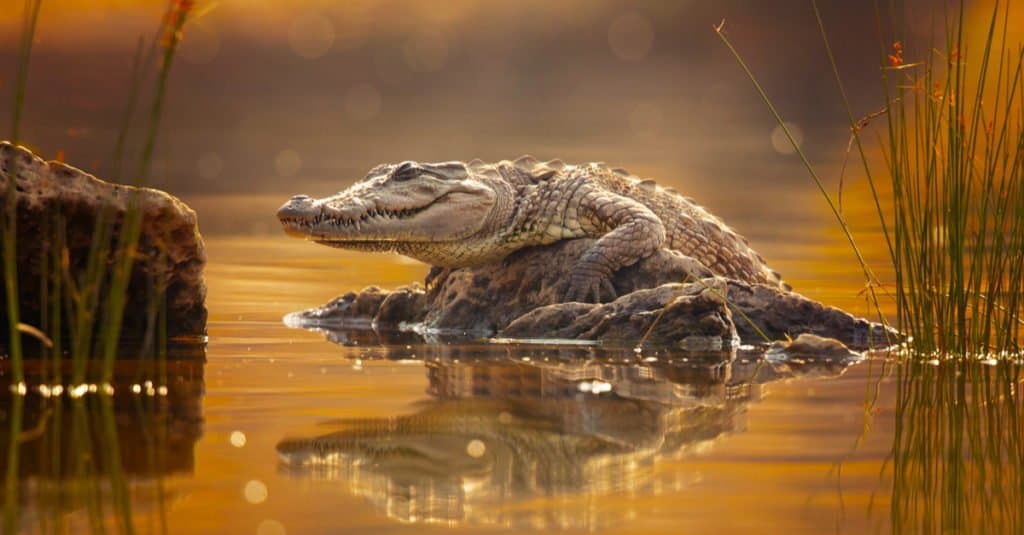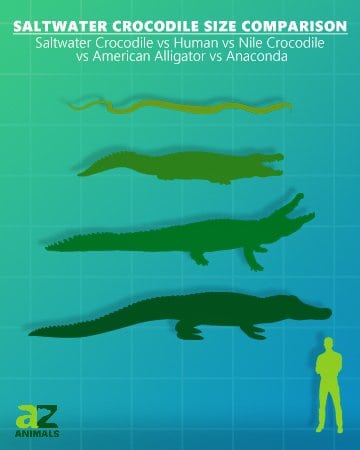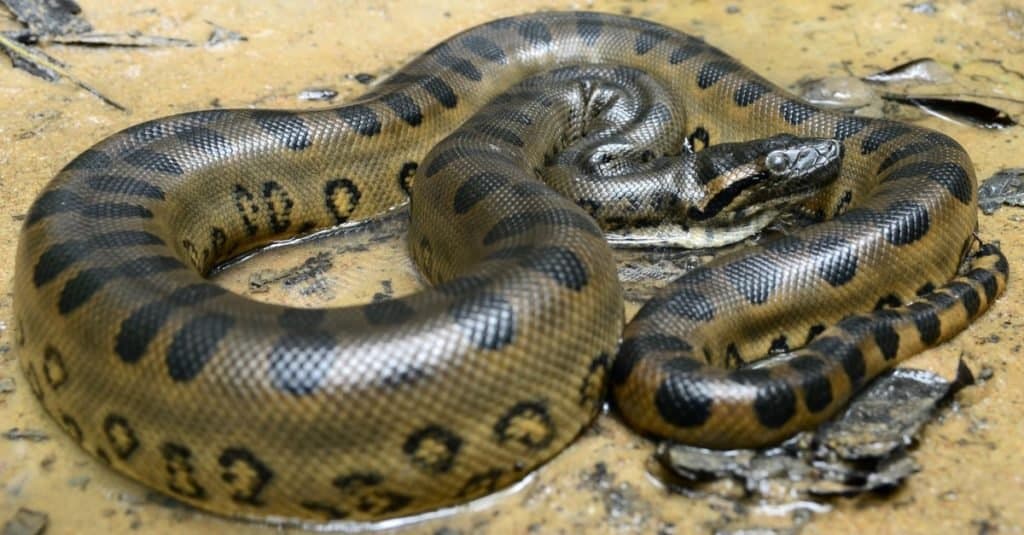
Did you know crocodiles lived in the same waters as some of the most dangerous prehistoric creatures? Few critters can claim that infamous fact, and the saltwater crocodile may just be able to thank its size for that. After all, how many other animals can claim the same length as a school bus or a 3,700 pounds per square inch bite? However, when it comes to a saltwater crocodile size comparison to some of the largest and deadliest modern water creatures, do you know how they’ll measure up?
Keep reading and learn more about the size of a saltwater crocodile, as well as just how big these prehistoric creatures can get!
How Big is a Saltwater Crocodile?

Saltwater crocodiles can grow up to a maximum of 23 feet and over 2200 pounds
©Milan Zygmunt/Shutterstock.com
Saltwater crocodiles are the largest type of crocodile as well as the largest reptile. And when you see just how big these prehistoric creatures are, you’ll understand just how they earned this world title.
On average, the size of a saltwater crocodile can be up to 17 feet in length, and it weighs around 1000 pounds – the same as 4 full-size refrigerators! However, they have been recorded to grow up to a maximum of 23 feet and over 2200 pounds! That’s over twice the length of an African bush elephant’s height!
Saltwater crocodiles can also get large in captivity! In 2012, the Guinness World Records announced that Lolong ( – February 2013) the saltwater crocodile was officially the largest crocodile in captivity. At the time of his measurement, Lolong was over 20 feet long and weighed 2,370 lb – also making him one of the largest recorded crocodiles ever!
Human Vs. Saltwater Crocodile Size Comparison

Did you know just a saltwater crocodile’s tail is longer than a human’s? In fact, much of a saltwater croc’s length comes from its tail. In a full-grown adult, their tail can be longer than 7 feet – much longer than the average human height!
Right now, the tallest human is just a little over 8 feet. This means it would take nearly three measurements of the tallest human to reach the same length as the largest saltwater crocodile! And when it comes to balancing the scale? It can take 13 average humans to weigh the same as a single supersized saltwater crocodile.
Even a saltwater crocodile’s teeth are larger, with many of their teeth growing to at least four inches. A human’s tooth is around the same size as a newborn croc’s tooth, but as they mature, that quickly changes.
Nile Crocodile Vs. Saltwater Crocodile Size

Nile crocodiles can grow to 20 feet long!
©ShutterOK/Shutterstock.com
When it comes to the largest crocodile, the Nile crocodile isn’t too far behind the title-holding saltwater croc.
Found in the Nile region, Nile crocodiles grow to an average of 500 pounds and 16 feet. While their maximum length is only around 20 feet, their weight can more than triple to 1,650 pounds at the most – much larger than the average saltwater crocodile. Their maximum length is also much larger than the maximum for a female saltwater crocodile, which, compared to its male counterpart, only grows to be around 10 feet in length.
However, when compared to Lolong, it would take nearly five average Nile crocodiles to balance the scale with him!
While Nile crocodiles are smaller than saltwater crocodiles, they tend to be much more aggressive than the latter, with a higher rate of attack and fatalities each year, although both species are the main cause of crocodile-related incidents each year.
American Alligator Vs. Saltwater Crocodile Size

An American
alligator
‘s teeth are almost 4 inches long!
©iStock.com/Bradley Proxmire
When it comes to crocodiles versus alligators as a whole, crocodiles tend to be larger than alligators. It’s a fact that proves true with the American alligator and the saltwater crocodile too.
If you live in the United States, you’re probably familiar with the American alligator – especially if you live in southeastern states like Florida. The American alligator is known to live in the freshwater marshes and rivers of the area. As a result, they’re already at a bit of a disadvantage compared to saltwater critters, who have more space and resources to grow larger.
At their average maximum, you’ll rarely find an American alligator over 13 feet long – the same as a Volkswagen Beetle – or 1000 pounds. This makes them nearly half the size of Lolong the saltwater crocodile and several feet smaller than the average croc.
The saltwater crocodile also has larger teeth, though only by around a quarter inch. While they’re slightly smaller, the American alligator has more teeth in its massive mouth, usually around 80 compared to the saltwater crocodile, who tends to have less than 70. Despite having more teeth, the alligator’s snout is smaller than the crocodile’s.
Anaconda Vs. Saltwater Crocodile

Newborn anacondas are two feet long!
©Patrick K. Campbell/Shutterstock.com
Unlike crocodiles, female anacondas are bigger than males. Known as one of the heaviest snakes in the world, female anacondas can reach lengths of up to 30 feet and weigh 550 pounds – the same as a baby grand piano!
Laid side by side, the green anaconda is around 10 feet longer than even the largest of saltwater crocodiles. However, it is only half the weight of the average saltwater croc and nearly a quarter of the largest of them all. Weight-wise, there isn’t that much difference between a comparison of sizes between a saltwater crocodile and an anaconda and a comparison with the American alligator.
Unlike other snakes that rely on venom, anacondas are a type of boa. This means that they rely on strangulation to hunt their prey. Then, thanks to their ability to open their mouth up to four times the girth of their body, they can easily swallow any prey. While they may not be able to eat a saltwater crocodile – nor do they share a habitat – anacondas have been known to attack and eat caiman and other small reptiles.
The smallest anaconda is the yellow anaconda. While the green anaconda may be able to outdo even the largest of saltwater crocodiles in terms of size, its smaller cousin only grows to around 13 feet in length. They usually don’t weigh more than a few pounds, but some studies have shown they can reach a max of 110 pounds – barely a fraction of the weight of a giant saltwater crocodile.
The photo featured at the top of this post is © iStock.com/SteveByland
Thank you for reading! Have some feedback for us? Contact the AZ Animals editorial team.






